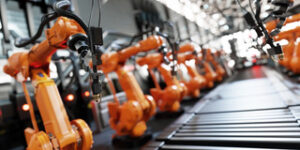 Welcome back to another piece regarding Industrial Automation Systems. In this blog, we shall talk about the various types of systems and their advantages for the manufacturers. Let’s begin!
Welcome back to another piece regarding Industrial Automation Systems. In this blog, we shall talk about the various types of systems and their advantages for the manufacturers. Let’s begin!
Ever since the surge of the industrial revolution, there has been a continuous need for automation and the complete transformation of quality-infused final products. Industrial automation calls for reducing human labor and better handling the production process through machines like a drill, conveyor belt, motors, etc.
Many industrial experts in the past decade have proposed the need for high volume and high-quality products which are highly reliable and less obsolete. Large production units and conglomerates have realized that catering to such a volume and value-based industrial production would require automation that has revolutionized the manufacturing sector and taken it by a storm.
On that note, let us understand the types of industrial automation systems available at the disposal of manufacturers today.
Its usability depends upon many factors and the types of manufactured products. Different industrial automation systems are leveraged and used in different scenarios differently. Some are data-driven, while others are output or production-led systems.
Fixed or Hard Automation:
The fixed or hard automation system automates a standard and fixed logical sequence of assembly operations or processing units. It uses sets of specific pieces of equipment to automate.
A manufacturing team or production line can use hard automation in its production process involving processes or assembly units programmed by a string of codes or commands. As governed by commands or lines of codes, it is usually difficult to accommodate or structure changes in the production or manufacturing process or assembly line.
This type of automation is usually meant for a specific purpose or application, as the case may be. It serves any manufacturing unit with the advantage of having a high production rate and low cost of units where a fixed or hard automation system is operational.
Some well-known areas or service applications where this type of automation system is installed are mechanized assemblies, machining transfer lines, and automated material handling.
Programmable Automation:
Programmable automation is one step ahead of fixed or hard automation. In this automation system, the user can accommodate and structure changes for different types and arenas of product configurations. Moreover, this automation system has well-designed production equipment that can handle changes resulting in the sequence of operations.
Many industry experts and analysts opine that programmable automation is well suited for batch manufacturing. Many leading manufacturing hubs use programmable automation systems when they manufacture their products batch-wise, as this system allows and is open for customization. It can also navigate frequent changes in the manufacturing process.
The programmable automation system offers flexibility and can deal with changes in the design variations in the entire manufacturing process. The user feeds in instructions in the form of codes, and the system deciphers and interprets these messages. The user can also feed in new information and instructions whenever a new product is manufactured.
Some industry-based applications of programmable automation systems are industrial robots, programmable logic controllers (PLC), and computer numerical controlled (CNC) machine tools.
Flexible or Soft Automation:
A flexible or soft automation system governs a higher level of  flexibility than fixed or programmable automation. A material handling system links several machine tools, and a centralized computer system controls all the components of the manufacturing system. Thus, this automation system offers much smoother and faster changes to products and processes.
flexibility than fixed or programmable automation. A material handling system links several machine tools, and a centralized computer system controls all the components of the manufacturing system. Thus, this automation system offers much smoother and faster changes to products and processes.
At any given time, a flexible automation system utilizes several tools linked to a material handling system; hence, this automation system can manufacture various parts without wasting even a fraction of time. The flexible or soft automation system also handles multiple configurations of products in no time and can handle the alteration of the physical set of those processes.
A manufacturing unit can enjoy several advantages of a flexible or soft automation system, such as handling continuous production of various mixtures of products and a medium production rate for the users.
Moreover, this automation system can handle flexible design variations and multiple lines of changes to product features. A robot arm is the most appropriate example of a flexible or soft automation system. It can be programmed to handle multiple tasks. Some of these can be inserting screws, drilling holes, inserting rivets, and spraying paints.
Totally Integrated Automation (TIA):
A totally integrated automation system is based on the concept and phenomenon of a common software environment backed by a common data management system and a common communication method. Totally integrated automation systems have higher productivity, lower costs, reduced complexities and take a shorter time to complete a particular process.
In today’s age, TIA is extremely useful and relevant and widely used in many industries, including automobile, general machine construction, plastics processing, food and beverages, and tobacco industries.
Conclusion:
Manufacturing has become faster and cheaper as the cost of production per unit scaled down with the advent of the industrial revolution and automation. While the benefits of each type of Industrial Automation system vary, a manufacturer can choose the most suitable system based on its advantages, configurations required, and the nature of production.
We hope you liked the series on Industrial Automation and shall talk about a new technology from the next blog onwards. Stay tuned to Rucha Yantra’s Knowledge Corner.
